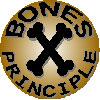E/W Vul
IMPs
Dealer: East
Lead:  A
A
oguz 8 8 7 3 7 3 A K J 2 A K J 2 K Q 8 7 6 4 K Q 8 7 6 4 |
||
gandolfo A K J 6 2 A K J 6 2 K 8 6 5 2 K 8 6 5 2 7 7 A J A J |
![[W - E]](http://gee.aaronhaspel.com/files/2012/10/t.gif) |
Maestro 10 9 5 4 3 10 9 5 4 3 A Q J A Q J 9 3 9 3 10 9 2 10 9 2 |
tony111 Q 7 Q 7 10 9 4 10 9 4 Q 10 8 6 5 4 Q 10 8 6 5 4 5 3 5 3 |
| West
2 |
North 1  3  4  |
East Pass 3  Pass |
South 1  Pass Pass |
Today’s auction is interesting, in the sense of that Chinese curse about interesting times. After North’s 1C opener and Gee’s pass, South begins the frivolity with a 1D response. 2D seems to me an apter description of the South hand, especially at favorable vulnerability, but a few months of writing this column have shown me that all I know, like Socrates, is that I know nothing.
West bids 2D, Michaels, to show his strong 5-5 hand. This looks best. Doubling, which is also possible, would not convey the distribution as well, while a sandwich 1NT or unusual 2NT would imply less high card strength.
The sequence of bids that follow 2D is disturbing. If you have a weak stomach, turn away now: go read the Honor Roll or Dr. Robert or something. First North’s 3D. Now if South had bid 2D, as he should, then North would have an easy raise to five at the vulnerability. He should probably bid 5D even so; it’s clear on the auction that E/W have an immense major-suit fit somewhere. However, he contents himself with 3D, and back we come to our hero.
Some players excite themselves at the prospect of a ten-card fit with an eight-carder on the side, but Gee keeps a cool head. After all, if the West hand is KJxxx Kxxxx xx x, then no game can make. Although West, with such a hand, has no business forcing his passed partner to bid with both unlimited at unfavorable vulnerability, experts like Gee can’t afford to depend on their partners to bid correctly. Sure, game is cold if West has anything like what he says has, and even slam makes on some West hands (like, for instance, the actual one); but why take a chance? Gee chooses a judicious 3S and awaits developments.
South’s pass is remarkable in its own right. His partner has shown nine or more cards in the minors. The opponents must have at least a nine-card spade fit. He has no defense and a known ten-card diamond fit. The vulnerability is favorable. If you won’t sac now, then when, O Lord?
West, in his turn, declines to bid, vulnerable at IMPs, what has to be at least a 50% spade game. And now Gee’s decision to wait pays off, as North gives him another chance by not passing out 3S. And not bidding 5C, giving his partner a choice of minor suit games. And not even bidding 5D. No, North bids 4D.
Gee finds the only way to cap this bidding sequence, by passing.
Down 1 for 50 won’t stack up too well at IMPs against a vulnerable slam, but why stop there? West opens the SA, and Gee carefully discourages with the 3. With a stiff in dummy the S10 would ask for a heart shift, but sometimes even great players forget that their lesser partners need help to read the cards as well as they do. West should probably find the heart anyway, but instead he shifts to the CA, then a trump, and sayonara. Making 5 for 150.
“I bid, did not I?” Gee asks after the hand. His partner does not reply.



